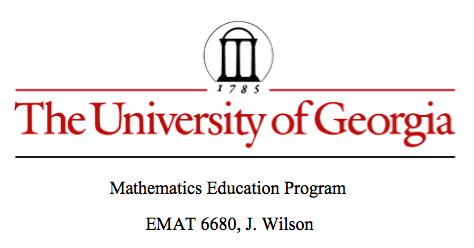

Assignment 7
Tangent Circles
by
Megan Dickerson
In starting this investigation, I learned how to create a script tool for the tangent circle to 2 circles.
To view and use my script tool click HERE.
The tangent circle in this tool looks like this:

Then, I decided to create a different script tool for the tangent circle to 2 given circles for when the tangent circle goes around the smaller circle like this:

The script tool for this case can be seen and used HERE.
After creating these 2 script tools, I decided to explore the loci of the centers of the tangent circle by animating the given point of tangency to the big circle. In order to fully consider this exploration, I had to look at all 3 cases for each of the 2 scripts.
CASE 1: one given circle lies fully inside the other.
CASE 2: the 2 given circles intersect one another.
CASE 3: the 2 given circles form completely disjoint circular regions.
First, I will show the 3 cases for the first script tool. The trace of the center of the tangent circle is shown in red as the given point of tangency is animated.
case 1:

Case 2:

Case 3:

Next, I will show the 3 cases for my second script tool. Again the trace of the center of the tangent circle as the point of tangency is animated is shown in red.
Case 1:

Case 2:

Case 3:

So. it appears that in all 6 cases either an ellipse or a hyperbola is formed. Half the time it appears to be an ellipse and the other half it appears to be a hyperbola.
Next, I decided to investigate the first case to see that in fact an ellipse was created.
I noticed by looking at the first picture that the centers of the 2 given circles appear to be the foci of the ellipse created by the trace. In order for these 2 points to be the foci, the sum of the distances from these 2 points to any point on the ellipse must be constant and equal to the major diameter.
The first part of this is proved by connecting each center (B and C) to the center of my tangent circle (A). I took the measure of each of these segments (AB and AC) and then the sum of their lengths. As I watched the animation play out (A was animated), that measure remained constant.
To view this and to animate it, click HERE.
However, that is just a visual. To prove that it is actually constant, I looked at how segment AB is congruent to segment AD since both consist of the radius of the tangent circle plus the radius of the small green given circle. So, the sum of AB +AC is equal to the length of DC. DC remains constant no matter where the point A is on the ellipse, so the sum of AB + AC must also remain constant.

So, I proved that the sum of the lengths from the foci to any point on the ellipse is constant, and now I need to prove that this sum is equal to the major diameter.
The sum of AB and AC is equal to CD. CD is the radius of the big circle +radius of the small circle.
The major axis or major diameter = the radius of the small circle + radius of tangent circle +radius of big circle - radius of tangent circle = radius of small circle + radius of big circle = CD = sum of AB and AC.
This proves that B and C are foci to the ellipse created as the center of the tangent circle was traced.